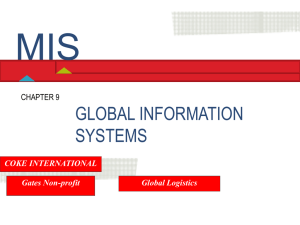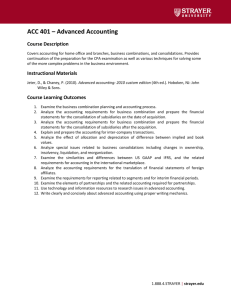TNCs’ global characteristics and subsidiaries’ performance across European regions*
advertisement
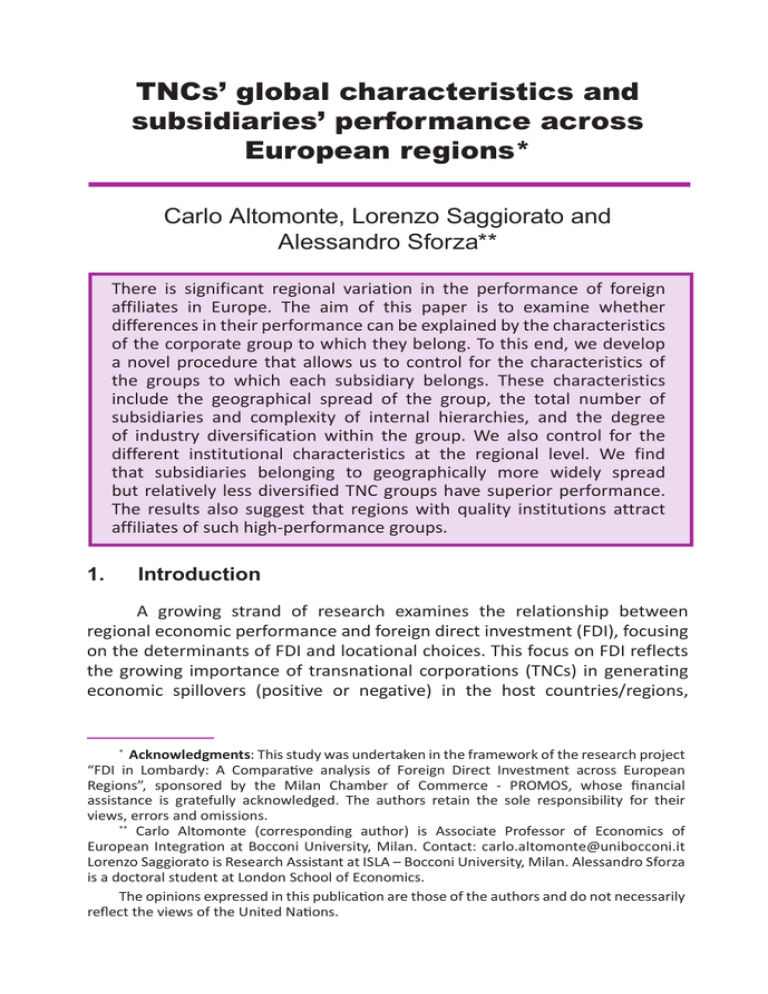
TNCs’ global characteristics and subsidiaries’ performance across European regions* Carlo Altomonte, Lorenzo Saggiorato and Alessandro Sforza** There is significant regional variation in the performance of foreign affiliates in Europe. The aim of this paper is to examine whether differences in their performance can be explained by the characteristics of the corporate group to which they belong. To this end, we develop a novel procedure that allows us to control for the characteristics of the groups to which each subsidiary belongs. These characteristics include the geographical spread of the group, the total number of subsidiaries and complexity of internal hierarchies, and the degree of industry diversification within the group. We also control for the different institutional characteristics at the regional level. We find that subsidiaries belonging to geographically more widely spread but relatively less diversified TNC groups have superior performance. The results also suggest that regions with quality institutions attract affiliates of such high-performance groups. 1.Introduction A growing strand of research examines the relationship between regional economic performance and foreign direct investment (FDI), focusing on the determinants of FDI and locational choices. This focus on FDI reflects the growing importance of transnational corporations (TNCs) in generating economic spillovers (positive or negative) in the host countries/regions, * Acknowledgments: This study was undertaken in the framework of the research project “FDI in Lombardy: A Comparative analysis of Foreign Direct Investment across European Regions”, sponsored by the Milan Chamber of Commerce - PROMOS, whose financial assistance is gratefully acknowledged. The authors retain the sole responsibility for their views, errors and omissions. ** Carlo Altomonte (corresponding author) is Associate Professor of Economics of European Integration at Bocconi University, Milan. Contact: carlo.altomonte@unibocconi.it Lorenzo Saggiorato is Research Assistant at ISLA – Bocconi University, Milan. Alessandro Sforza is a doctoral student at London School of Economics. The opinions expressed in this publication are those of the authors and do not necessarily reflect the views of the United Nations. which, due to their large average size, might significantly affect the growth path of the host economies.1 Indeed, a number of TNC characteristics might affect the extent to which FDI can influence the performance of host economies, with the most important determinants being the technology gap between domestic and foreign firms, the ownership structure of investment projects (Havranek and Irsova, 2011a, 2011b) and the degree of development of financial markets (Alfaro et al., 2010). Evidence suggests that the magnitude of TNCs’ impact on regional disparities can be considerable because TNCs’ investment projects result in varied speeds of industrial restructuring across regions (Altomonte and Colantone, 2008). In this study, we follow up on this approach and assess whether and to what extent the performance of TNCs’ affiliates varies across regions.2 In order to explain these differences, we develop a novel procedure that allows us to control for the global characteristics of the corporate group to which each subsidiary belongs, such as the total number of subsidiaries, their geographical spread, and the degree of industry diversification within the group.3 We find that subsidiaries belonging to a TNC group that is geographically more widely spread but less diversified in terms of business activities have superior performance on average, although most of the regional variation in the results are linked to different local institutional settings and the specific industrial structure of each region. The results are robust to the introduction of a series of firm and regional characteristics. 1 OECD (2007) provides a detailed study on the effects that globalization and TNCs are having on regional development. 2 This paper is part of a wider research project conducted for the “Invest in Milan” service of the Milan Chamber of Commerce – Promos, responsible for attracting foreign direct investments to Milan and Lombardy. In the research project, we analysed some 69,000 TNCs affiliates that invested in the 12 European regions that attracted most FDI from 2002 to 2007 and explored the extent to which different regional and industry characteristics contribute to differing impacts of foreign investment. 3 Khanna and Palepu (2000) were the first to analyse the extent to which firms benefit from affiliation to business groups, with respect to the degree of diversification of the group and to the market institutional framework. Colpan and Hikino (2010) provided a recent summary of the literature on business groups and their effects on a country’s performance. 2 Transnational Corporations, Vol. 21, No. 2 (August 2012) The rest of the paper is organized as follows. Section 2 describes the dataset and presents some preliminary findings with respect to the main variables of interest. Section 3 introduces the strategy used to obtain information on the TNCs. In Section 4, we present the empirical strategy and the results obtained. Section 5 assesses the role of institutional quality. Section 6 concludes. 2. Description of the dataset The data used in the paper come from two firm-level databases, Amadeus and Orbis, provided by Bureau van Dijk.4 Amadeus contains financial information on almost 20 million firms all over Europe, observed over a period of around 10 years, while Orbis contains information on the firms’ ownership structure and control chains worldwide. A key feature of these datasets is the richness of information provided for each firm. Moreover, most of the indicators are reported over time, enabling the construction of a panel dataset. In order to retrieve information on the Nuts2 region5 in which each firm is located, we have used information provided by the variable, “region”, available in the Amadeus database. Since this variable does not always match the regional classification as specified by the Nuts2 classification of Eurostat, we have assigned manually the Nuts2 code to each region using information gathered from the address of the firm. The focus of this research was on the 12 regions across Europe that are most competitive in attracting FDI. These regions are the Capital Region of Brussels in Belgium, Île-de-France and Rhône-Alpes in France, Baden-Württemberg, Bayern and Brandenburg in Germany, Leinster in Ireland, Lombardy in Italy, Cataluña and Madrid in Spain, and InnerLondon and Outer-London in the United Kingdom. The standard OECD definition of FDI (OECD, 2008) has then been applied to identify foreign affiliates in the selected regions, i.e. firms with a foreign shareholder owning at least 10 per cent of the voting stock. A threshold on the size Bureau van Dijk is a company that collects and provides firm-level balance sheet data. They also collect data on macroeconomic indicators as well as information on M&A deals. For details, refer to the web page: www.bvdinfo.com. 5 Nuts2 is an EC geocode standard classification to identify regional entities. 4 Transnational Corporations, Vol. 21, No. 2 (August 2012) 3 of the firm has also been added, in order to exclude very small firms which are not of primary interest for the present analysis.6 Table 1 provides an overview of the distribution of foreign affiliates in different regions. Unlike other regions identified within Nuts2, Lombardy in Italy has been split into Milan’s province and its remaining provinces. The reason for this choice is that Lombardy as a whole is much larger in terms of geographical area, population and GDP than the other regions under analysis. Table 1. Distribution of foreign affiliates in the selected regions Region Brussels Capital Region No. of foreign affiliates 780 Baden-Württemberg 1,155 Bayern 1,623 Brandenburg 115 Madrid 3,475 Cataluña 3,626 Île-de-France 12,565 Rhône-Alpes 6,817 Leinster 1,507 Lombardy (Milan) 12,982 Lombardy (No Milan) 15,012 Inner London 6,902 Outer London 2,429 Whole sample 68,988 In order to identify the relevant corporate groups, we started from the OECD definition of foreign affiliates, i.e. at least 10 per cent of the voting stock is held by a foreign group. According to this criterion, the database identifies 68,988 foreign affiliates located in the 12 regions. Out of the 68,988 foreign affiliates, we took the decision to select only those firms that are majority-owned by a corporation, i.e. subsidiaries 6 Given the different accounting rules of the countries in the sample and incomplete data, the threshold was set as either sales, operating revenues or value added being greater than one million euro, for the last year for which data were available. 4 Transnational Corporations, Vol. 21, No. 2 (August 2012) owned by a corporation. We will refer to the corporate entity at the top of the control chain that has directly or indirectly more than 50.01 per cent of the voting power of the subsidiaries as the ultimate owner (UO).7 One may argue that considering only the relationships above the threshold of 50.01 per cent omits a large number of important minority participations and those foreign affiliates owned by individuals, especially at lower levels of control. It also overlooks the issue of crossparticipations and strategic alliances. On the other hand, the 50 per cent criterion is appealing precisely because it enables a perfect partition of the affiliates in the sample into mutually exclusive corporate groups, thus avoiding the potential problem of affiliates which could be equally linked to two or more headquarters. We have also excluded foreign affiliates controlled by individuals, since we are interested only in those affiliates for which we have information on the ultimate owner, so as to have a complete picture of the group’s structure. All the firms in the sample are foreign affiliates, but some of them have a domestic firm as the ultimate owner (i.e. a firm headquartered in the same country as the location of the foreign affiliate). Thus, of the 20,815 subsidiaries in the sample, only 15,699 are actually majorityowned by a foreign corporation (table 2). For the analysis of the subsidiaries, we focused on some key variables covering different dimensions of performance. These were total assets8, total number of employees, operating revenues (turnover) and value added. In addition, two standard summary measures of profitability were considered, namely return on equity (ROE) and earnings before interest and tax (EBIT), both available from Amadeus. Another important dimension of the dataset is the industry in which a firm operates: this is, in principle, classified according to the NACE Revision 2 code of the European Commission. In order to be able to handle the information on the industry of activity, thus avoiding an The identities of the ultimate owner are provided by Orbis. Note that total assets have been chosen as a proxy of capital, instead of fixed assets, because the sample includes firms operating in all sectors of activity, including services, where intangibles are highly relevant. 7 8 Transnational Corporations, Vol. 21, No. 2 (August 2012) 5 excessive disaggregation of the sectors, we made use of a slightly modified version of the Pavitt taxonomy (Pavitt, 1984), aggregating the sectors into six broad categories, namely, economies of scale industries, traditional industries, specialized industries, high-tech industries, services, and wholesale & retail. Table 2. Definition of FDI in our sample Classification Foreign affiliates Corporate-owned foreign affiliates Foreign subsidiaries Definition No. of firms ≥10% participation by foreign firm 68,988 ≥10% participation by foreign firm + UO 20,815 (50%, corporate) Majority owned by foreign corporate 15,699 UO In order to complete the framework of information available at the firm level, we added three measures of firm-level productivity, which are widely used in economic literature: unit labour cost (ULC), labour productivity (LP) and total factor productivity (TFP). Unit labour cost is measured as the ratio between the cost of employees and value added. Labour productivity is obtained by dividing value added by the number of employees. Total factor productivity is derived as the residual term of the estimate of the production function. In order to obtain consistent estimates, we adopted the semi-parametric methodology suggested by Levinsohn and Petrin (Levinsohn and Petrin, 2003) applied by industry. Before we proceed to the analysis based on the sample of 20,815 subsidiaries, it is worth considering the possibility of the selection bias in the sample. Table 3 shows the average of the key indicators used in the analysis. It is clear that the affiliates of TNC groups owned by individuals or minority-owned by corporations, which together make up the majority of the firms in the sample, are much smaller than those that are majority corporate-owned, with respect to almost all the measures considered. An exception is ROE, but this is not surprising because larger firms have much higher paid-in equity reserves, thus driving the ratio downwards. Controlling for country and industry fixed-effects in our estimates enables us to address the concern of a compositional effect possibly driven by an uneven selection bias across countries or industries. 6 Transnational Corporations, Vol. 21, No. 2 (August 2012) Table 3. Foreign affiliates’ characteristics1 No. of No. of Total ROE Revenues2) EBIT2) firms Employees Assets2) (%) Ownership Majority corporate20,815 owned 129.32 217 41 15.79 1.8 K/L LP 706.98 124.2 ULC TFP 0.7 3.78 Minority corporate owned or individual-owned 48,173 28.09 7 7 19.05 0.3 375.7 81.91 0.67 2.34 Total 68,988 57.99 70 16 18.11 0.7 473.42 93.35 0.68 2.73 Source: authors’ calculations Note: 1) All the indicators of the firm performance are averages 2) In millions of euros. In terms of distribution across regions, we also find that affiliates located in different regions are heterogeneous in terms of firm characteristics and performance. Table 4. Foreign affiliates’ characteristics by regions1 Region Brussels Capital Region No. of No. of Total Revenues2 firms Employees Assets2 ROE (%) EBIT2 K/L LP 780 113.79 48.02 48.02 15.81 2.23 1106.17 182.93 Baden-Württemberg 1155 240.43 51.01 51.01 15.42 3.55 350.90 98.90 Bayern 1623 210.51 43.41 43.41 12.33 3.16 526.05 116.77 115 187.44 38.04 38.04 14.41 3.27 346.19 80.15 Madrid Brandenburg 3475 97.34 30.64 30.64 19.39 1.41 545.16 99.12 Cataluña 3626 64.41 17.44 17.44 16.10 0.72 330.97 75.85 12565 45.72 15.12 15.12 23.20 0.62 383.27 107.07 Île-de-France Rhône-Alpes 6817 29.20 7.42 7.42 23.78 0.31 223.44 79.14 Leinster 1507 105.32 38.17 38.17 25.82 2.42 983.12 73.56 12982 42.83 12.81 12.81 12.49 0.55 550.36 92.87 Lombardy (No Milan) 15012 27.01 6.45 6.45 11.81 0.31 412.95 72.29 Lombardy (Milan) Inner London 6902 107.35 27.63 27.63 25.73 1.30 885.30 146.34 Outer London 2429 154.08 31.75 31.75 28.72 1.18 518.20 92.42 Whole sample 68988 57.99 16.73 16.73 18.11 0.75 473.42 93.35 Source: authors’ calculations Note: 1) All the indicators of the firm performance are averages 2) In millions of euros. Transnational Corporations, Vol. 21, No. 2 (August 2012) 7 We notice, for instance, that associates located in Germany are typically much larger than the average with respect to the number of employees, total assets and revenues, although this may well be due to the selection bias in retrieving data for affiliates in Germany9. Conversely, it emerges that affiliates located in Lombardy are much smaller in terms of size and profitability measures, which is consistent with the well-known characteristics of the Italian industrial structure. We now turn to the determinants of this heterogeneity in performance, linking them to the global characteristics of the parent groups to which the subsidiaries belong. 3. The characteristics of the parent groups In this section, we assess the extent to which the characteristics of the parent groups might explain the variations in the performances of the subsidiaries across the regions. When analysing subsidiaries, it is reasonable to consider them as part of the complex framework of the broader corporate group rather than as a stand-alone entity. However, from an empirical point of view, switching from a strictly firm-level approach to the parent group level is not straightforward. It becomes necessary to define the group’s boundaries. Following the approach suggested by Altomonte and others (Altomonte et al., 2012), a group is defined through the criterion of “full control”, thus implying an equity participation of more than 50.01 per cent at every stage of the control chain. This procedure, despite being demanding and possibly excluding some relevant group affiliation existing with lower levels of participation, guarantees the uniqueness of the ultimate owner of each FDI. We implemented a three-step procedure to merge information on TNC groups with the baseline database already described, i.e. to link each foreign subsidiary in the database with the TNC group it belongs to. First, the variables “UO identifier”10 and “UO type” were 9 The relatively small number of firms found in the richest German Länder, together with their average firm-level characteristics, in terms of all the indicators considered, far above those of all the other regions in the sample suggests that we might be getting information mainly on the biggest players in the regions. 10 To identify a single firm the BvD Identifier is used. It is a code provided by 8 Transnational Corporations, Vol. 21, No. 2 (August 2012) downloaded from the Amadeus database for all the subsidiaries in the sample. Then, these codes were inserted in Orbis in order to obtain the following data: the name, the headquarters’ location, the list of the codes of all subsidiaries of the TNCs with the level of control of each subsidiary, and the sector of activity according to the NACE Revision 2 code. These data were combined in order to obtain group-specific information, as discussed below. The data obtained were then merged with the baseline dataset. From the list of worldwide subsidiaries downloaded for each TNC group, we were able to ascertain a number of firm characteristics relevant for our analysis. First, the location of the ultimate owner and all the subsidiaries were identified. Relying on the OECD 2009 “List of Unco-operative Tax Havens”, those TNC groups that have subsidiaries in a tax haven and those TNCs groups whose headquarters itself is located in a tax haven were identified.11 Furthermore, we were able to establish the total number of subsidiaries, as well as the number of countries where the group has subsidiaries. We also created a dummy variable (Global) indicating whether the group’s subsidiaries are spread over more than one continent or all its subsidiaries are located in the same continent as the headquarters. In terms of industry diversification, we created a variable indicating the share of subsidiaries active in sectors (2-digit NACE Revision 2 aggregation) outside the core business of the group. A variable marking those groups that own subsidiaries involved in financial activities was also added.12 Furthermore, to consider some proxy of the complexity of the group, we retrieved information on the hierarchical level of control of each subsidiary, i.e. the number of control participations that divide one subsidiary from its ultimate owner, and introduce a variable indicating the maximum level of control existing within the structure of each group. Bureau van Dijk, which is unique for each firm and constant over time. 11 The OECD classified the following countries as tax havens: Andorra, Anguilla, Antigua and Barbuda, Aruba, Bahamas, Bahrain, Belize, British Virgin Islands, Cayman Islands, Dominica, Gibraltar, Grenada, Liberia, Liechtenstein, Marshall Islands, Monaco, Montserrat, Nauru, Netherlands Antilles, Niue, Panama, St Kittis and Nevis, St Lucia, St Vincent and Grenadines, Samoa, San Marino, Turks and Caicos Islands, Vanuatu. The following countries are classified as other financial centres: Austria, Belgium, Brunei, Chile, Guatemala, Luxembourg, Singapore, Switzerland. The following countries have not committed to the internationally agreed tax standard: Costa Rica, Malaysia (Labuan), the Philippines, Uruguay. 12 They are identified as those engaged in financial and insurance activities as well as real estate. Transnational Corporations, Vol. 21, No. 2 (August 2012) 9 Table 5 describes the dataset with respect to the group-specific variables introduced above, tabulated by region. Table 5. Descriptive statistics of TNC groups characteristics Avg. N. Subs. N. of of which N. of Avg. N. of Financial Diversiof subsiTax Global firms UO info groups countries branch fication diaries Haven Region Brussels Capital Region BadenWürttemberg 745 668 420 226.7 33.3 1 0.92 0.91 0.72 768 678 520 136.3 23.3 0.8 0.88 0.72 0.69 1,041 926 706 131.1 21.9 0.8 0.83 0.71 0.68 77 67 56 233.6 24.1 0.73 0.82 0.71 0.68 Madrid 1,926 1,777 1,186 148.1 24.3 0.86 0.87 0.79 0.69 Cataluña 1,316 1,239 942 129.3 21.8 0.8 0.87 0.72 0.67 Île-de-France 3,636 2,838 1,749 119.2 21.3 0.82 0.89 0.75 0.68 Rhône-Alpes 894 576 433 144 21 0.75 0.81 0.73 0.65 1,300 1,034 733 174.7 24.5 0.74 0.88 0.85 0.65 Lombardy (Milan) 2,521 1,955 1,285 127.4 22.3 0.76 0.82 0.73 0.65 97.4 15.9 0.53 0.61 0.61 0.56 Bayern Brandenburg Leinster Lombardy (No Milan) 1,149 660 507 Inner London 4,431 3,690 2,448 71.1 10.5 0.5 0.86 0.58 0.51 Outer London 1,011 890 635 114.1 18.5 0.65 0.88 0.64 0.63 20,815 16,998 6,6531) 57.8 10.9 0.55 0.77 0.58 0.55 Whole sample Source: Authors’ calculations. Note: The numbers in the column do not add up to the total because many groups have a subsidiary in more than one region. The third column of Table 5 represents the shift from the firmlevel to the group-level; it is the number of TNC groups owning the subsidiaries listed in the second column (e.g. there are 420 groups that control at least one subsidiary in the Brussels Capital Region). The remaining columns present the variables discussed above, which are the average number of the subsidiaries of the same group worldwide, the average number of countries in which the groups have subsidiaries, the share of groups having at least one subsidiary located in a tax haven13, the share of groups having at least one subsidiary in a continent different from the headquarters’ location, the share of groups having at Notice that the figure for Belgium takes value one because it appears itself in the OECD list on unco-operative countries. 13 10 Transnational Corporations, Vol. 21, No. 2 (August 2012) least one subsidiary active in a finance-related sector, and the degree of diversification, proxied by the share of subsidiaries within each group active in a sector different from the core business. The table provides information in terms of similarities and heterogeneity of the parent groups active in the selected regions. If we consider, for instance, the size of the groups, measured both in terms of total number of subsidiaries worldwide and geographical spread, the table provides an extremely heterogeneous picture. The number of subsidiaries ranges from Inner London, with a value of 71.1 subsidiaries (that is, a group that has a subsidiary in Inner London has, on average, 71.1 subsidiaries in the group), to the higher values reached in Brandenburg and Brussels, respectively of 233.6 and 226.7 subsidiaries per group. Not surprisingly, this variable is by and large proportional to the geographical spread of the group. The latter shows again a differentiated picture, with TNCs that have a subsidiary in some regions being almost three times as widely spread as those that have a subsidiary in other regions. More than half of the groups have at least one subsidiary located in a tax haven, in all the regions in the sample, but again there is wide variation across the regions. With respect to the presence of financerelated firms within the TNC, the percentage of groups that own at least one finance-related subsidiary ranges from 60 to 90 per cent across the regions. This feature is relevant given the important role played by internal capital markets in the performance of TNC groups.14 The extent to which TNCs groups have established subsidiaries in more than one European country under analysis can be seen from figure 1. The chart shows the percentages of groups that invest in the different countries conditional on the fact that they have already invested in another country. For example, observing the first group of bars in figure 1, one can deduce that around 70 per cent of the foreign TNCs investing in Italy have also invested in the United Kingdom and around 40 per cent also in Belgium. Hence, the message provided by figure 1 is that the vast majority of the groups observed are active in at least two countries of the sample; all the countries appear very similar See Stein (1997) and Rajan et al. (2000) for two relevant different perspectives on the topic. 14 Transnational Corporations, Vol. 21, No. 2 (August 2012) 11 to each others, with only the United Kingdom recording a slightly more “isolated” pattern of investment. Figure 1. Patterns of TNCs establishing subsidiaries across sample regions 100 90 80 70 Italy 60 France 50 Germany 40 Spain 30 United Kingdom Belgium 20 10 0 Italy France Germany Spain United Kingdom Belgium Source: authors’ calculations. 4. Estimation methodology and results All the analysis presented so far on TNCs has to be checked against the question of whether group-related features can influence the performances of subsidiaries in different regions. The framework of analysis is a linear model, as in equation (1): Π igt = α + β X igt + γ Z g + δ F E + ε igt , (1) where the dependent variable is alternatively the natural logarithm of TFP, of ROE, or of EBIT. X igt is a set of firm-specific variables controlling for the number of employees and the capital-labour ratio, FE is a set of industry and regional fixed-effects, and Z g is a matrix of the timeinvariant set of group-specific variables presented above. The 12 Transnational Corporations, Vol. 21, No. 2 (August 2012) model is estimated by ordinary least squares and the error terms are clustered by group identifier. Table 6 provides the results of the estimates respectively on TFP, ROE and EBIT. Table 6. Estimation results VARIABLES N. subsidiaries N. countries Global Financial branch Diversification Subsidiaries in Tax Haven (1) (2) (3) ln TFP ln ROE ln EBIT -0.0392*** 0.0126 0.00450 (0.0133) (0.0390) (0.0254) 0.114*** 0.115*** 0.112*** (0.0156) (0.0389) (0.0310) 0.0516 -0.0289 0.0390 (0.0355) (0.0714) (0.0684) 0.481*** 0.364*** 0.446*** (0.0824) (0.140) (0.133) -0.0805* -0.372*** -0.255*** (0.0446) (0.121) (0.0857) -0.0386 -0.0183 0.0172 (0.0604) (0.126) (0.124) Headquarter in Tax Haven -0.0247 -0.0730* -0.0855** (0.0183) (0.0401) (0.0386) Max number of hierarchical levels -0.00221 0.00487 -0.00572 (0.00463) (0.0124) (0.00829) -1.311*** 3.268*** -1.134*** (0.168) (0.380) (0.273) Observations 45,299 29,429 30,138 Constant R-squared 0.422 0.068 0.658 Region FE YES YES YES Sector FE YES YES YES Year FE YES YES YES Robust standard errors in parentheses *** p<0.01, ** p<0.05, * p<0.1 Observing table 6, we notice that there are some groupspecific characteristics that significantly impact on the performance of subsidiaries, with respect to all the three indicators considered. In particular, it emerges that the geographical spread has a positive and Transnational Corporations, Vol. 21, No. 2 (August 2012) 13 significant impact on the performance, i.e. subsidiaries belonging to geographically more widespread TNC groups show, on average, a higher level of profitability and productivity. Another variable which seems important in shaping firm-level performance is the presence of finance-related subsidiaries within the group.15 These findings are consistent with a model of international production in which global value chains play a prominent role, as geographical diversification of a TNC group allows subsidiaries to better capture localization advantages across markets. Within these organizational setups, it is also known that a crucial role is played by internal capital markets, with a vast theoretical and empirical literature emphasizing how the availability of internally generated liquidity enhances firms’ investment capacity in environments where access to external funds is limited (Stein, 1997). With respect to the profitability measures, we find a negative and significant impact of the degree of industry diversification within the group (less significant when it comes to productivity), suggesting that a high dispersion of the activities of the group is negatively related with the performance of the subsidiaries. Finally, subsidiaries of TNCs with the headquarters located in tax havens tend to report, ceteris paribus, some 8 per cent lower profits. However, a possible effect of tax distortion, proxied by the presence of subsidiaries in tax havens, does not seem to be significant neither in terms of productivity nor of profitability. Table 6 thus provides evidence that TNC groups’ characteristics matter for the subsidiary-level performance, in line with the general trend in the organization of international production aimed at the creation of global value chains. The question remains as to whether these diverse characteristics of TNCs can account for the differences in the average performance of foreign subsidiaries across the regions. One difficulty in the analysis 15 Since the model includes sector fixed-effects, the share of subsidiaries with financial specialization does not impact firm performance via an industry-driven compositional effect (groups operating in the financial sector might have a larger share of finance-involved subsidiaries and higher profits), as this effect would be absorbed by the sector-specific intercepts. 14 Transnational Corporations, Vol. 21, No. 2 (August 2012) is that, as figure 1 shows, the vast majority of TNCs identified in our sample invests in more than one region. This location pattern lowers the explanatory power of TNCs’ characteristics in explaining regional heterogeneity. To explore this issue further, we have compared the regional fixed-effects obtained from the estimate of equation (1) with those obtained from the regression of the same equation without the matrix containing the TNCs’ characteristics. The intuition is that, if the regional fixed-effects estimated in the equation with groups’ characteristics are lower than the ones estimated only with firm-level variables, it implies that the group characteristics of subsidiaries differ across the region, and thus are able to explain the regional variation in the performance of foreign subsidiaries. Next section actually shows that the group characteristics do not explain regional fixed-effects on the performance of the subsidiaries. Instead, it is the institutional quality that has significant impact on the performance of the foreign subsidiaries in the region. Furthermore, the regression results suggest that TNCs’ group characteristics that are associated with better performance of the subsidiaries are correlated with the regional institutional quality. Clearly this issue requires further research, but the results obtained are consistent with the thesis that a region with quality institutions attracts investment from TNC groups that exhibit the characteristics of high performance, and hence foreign subsidiaries in such a region are seen to be performing well. 5. TNC characteristics and Institutions Group characteristics matter for the subsidiary-level performance, but their role in explaining differences in regional economic performance is controversial given the large number of TNCs have subsidiaries in more than one region. In order to examine this issue, in the first two columns of table 7, we compare the regional fixed effects obtained from the estimate of equation (1) with and without the matrix Z g , which contains the group characteristics. If the regional fixed effects estimated in the equation with the group characteristics are lower than the ones estimated only with firm-level variables, it implies that group Transnational Corporations, Vol. 21, No. 2 (August 2012) 15 characteristics differ on average from one region to the other in the sample and are actually effective in explaining part of the regional heterogeneity. However, it emerges from the comparison of the first two columns that the introduction of TNCs’ characteristics does not absorb the regional fixed effects, suggesting that groups’ characteristics, although having a significant impact on the subsidiary performance, are not effective in explaining regional performances. The fact that the group characteristics do not explain regional fixed effects can be due to an autocorrelation across regional fixed effects, with the former arising because TNC groups invest, to a large extent, in more than one region in the sample, as shown in figure 1. In order to deal with the issue, we investigate the relationship between the density of TNC groups and institutional quality. To measure the latter, we constructed a standard indicator of institutional quality (INST) as weighted average of World Bank variables such as rule of law, government effectiveness, corruption and regulatory quality.16 If we now compare the first and the third columns of table 7, we notice that institutional characteristics do often lower the regional coefficients. However, the institutional variable (INST) in column (3) is not significant; this is consistent with the possibility that the institutional indicator is correlated with the TNCs’ characteristics also included in the estimate, essentially mapping the same heterogeneity across regions. In column (4), we estimate the same regression as in column (3) but on the whole sample (i.e. including all affiliates). We notice that the regional fixed effects remain almost the same as the previous specification while the institutional variable acquires significance and it shows the correct sign, thus adding support to the previous explanation. Weights are assigned proportionally to the variance of each indicator in the sample, in order to highlight differences among the different institutional settings. 16 16 Transnational Corporations, Vol. 21, No. 2 (August 2012) Table 7. Regional fixed-effects comparison VARIABLES Baden-Württemberg Bayern Brandenburg Madrid Cataluña Île-de-France Rhône-Alpes Leinster Lombardy (Milan) Lombardy (No Milan) Inner London Outer London (1) (2) (3) (4) ln TFP ln TFP ln TFP ln TFP -0.186*** -0.180*** -0.559*** -0.503*** (0.0319) (0.0318) (0.106) (0.0571) -0.153*** -0.172*** -0.587*** -0.529*** (0.0314) (0.0307) (0.121) (0.0644) 0.388*** 0.413*** 0.340*** 0.270*** (0.0757) (0.0802) (0.0764) (0.0648) 0.621*** 0.607*** 0.382*** 0.347*** (0.0277) (0.0267) (0.0658) (0.0386) 0.639*** 0.644*** 0.436*** 0.388*** (0.0277) (0.0268) (0.0567) (0.0349) 0.455*** 0.442*** -0.0556 0.0281 (0.0270) (0.0262) (0.136) (0.0687) 0.320*** 0.326*** 0.156*** 0.211*** (0.0311) (0.0300) (0.0525) (0.0330) -1.231*** -1.094** -1.275*** -1.120*** (0.422) (0.431) (0.422) (0.333) 0.778*** 0.775*** 0.512*** 0.494*** (0.0275) (0.0261) (0.0685) (0.0369) 0.475*** 0.542*** 0.209*** 0.229*** (0.0305) (0.0300) (0.0697) (0.0370) -0.309*** -0.294*** -0.414*** -0.437*** (0.0304) (0.0299) (0.0437) (0.0326) -0.288*** -0.290*** -0.420*** -0.495*** (0.0339) (0.0355) (0.0504) (0.0352) -0.0452 0.0476*** INST (0.0320) (0.0146) -1.053*** -1.365*** -0.989*** -1.175*** (0.0488) (0.167) (0.0704) (0.0396) YES NO YES NO Observations 45,299 45,299 45,299 185,408 R-squared 0.384 0.422 0.385 0.367 Constant TNC Characteristics Robust standard errors in parentheses *** p<0.01, ** p<0.05, * p<0.1 Transnational Corporations, Vol. 21, No. 2 (August 2012) 17 6.Conclusions The aim of the research was to study the performance of foreign affiliates located in twelve ‘top’ European regions, chosen among those that attract the highest number of FDI projects, including London, Rhône-Alpes, Île-de-France, Brussels, Madrid, Cataluña and Bayern. The resulting sample is composed of 20,815 foreign affiliates, observed over a time span of eight years from 2002 to 2009. In order to investigate the origin of the performance’s differences among foreign affiliates, we developed a novel technique that enables us to retrieve information on the TNC group controlling the subsidiary and to create a set of TNC group-specific variables, such as the total number of group’s subsidiaries, the number of countries where the group is active and the extent to which the group is diversified. The estimate of an ordinary least squared model suggests that there are, indeed, some TNC-level characteristics that matter in explaining firm-level performance (both profitability, measured by ROE and EBIT, and productivity, measured as TFP). Furthermore, we found that TNCs that control subsidiaries in the sample are likely to invest in more than one single region (as shown in figure 1), thus reducing the ability of the group-level variables to explain the regional heterogeneity. Finally, the results suggest that the quality of institutions impact on the type of TNC subsidiaries a region can attract, as we found a sound correlation between the proxy of institutional quality and TNC group-level characteristics. The analysis allows us to draw some relevant policy implications. It emerges, indeed, that corporate-owned subsidiaries, which tend to be large, outperform those affiliates owned by individuals or by corporations with less than 50 per cent equity holding. The subsidiaries of a group that has a subsidiary in the financial industry are also shown to perform better. The latter result is consistent with the growing literature on the internal capital markets, which suggests that subsidiaries can benefit from the presence of a financing arm within the group as those allow easier access to the capital markets. The better performance of subsidiaries belonging to larger TNCs might be related to the geographical spread of the group that gives easier direct access to a large number of markets without incurring the costs related to marketing across borders. Finally, what we find in our analysis is that industry diversification within the TNC is, ceteris paribus, negatively 18 Transnational Corporations, Vol. 21, No. 2 (August 2012) and significantly related to firm-level performance. Another relevant finding obtained is that the presence of TNCs is closely linked to the institutional quality. This correlation could be interpreted in two ways: the presence of TNCs could somehow influence and shape institutions or, more likely, TNC groups are more inclined to locate subsidiaries in regions with higher quality institutions. Pursuing this issue goes beyond the scope of this research. However these findings suggest that it would be worth trying to find a way to deal with the endogeneity problem highlighted, as this would enable a proper assessment of the causal relationship and to address more specifically the relationship between institutional quality and the characteristics of the TNCs that work in the country. From a regional economic policy perspective, it may be worth attracting investments from relatively more geographically spread groups, benefitting from their own financial resources, as this may increase regional aggregate performance, together with the possibility of inducing a virtuous circle mechanism on the quality of local institutions. With this respect, working primarily on institutional quality, thus committing to promoting contract enforcement and to fighting corruption could be an important trigger for the attraction of TNCs. References Alfaro, L., Chanda, A., Kalemli-Ozcan, S., and Sayek, S. (2010). Does Foreign Direct Investment promote growth? Exploring the role of financial markets on linkages. Journal of Development Economics, 91(2):242-256. Altomonte, C. and Colantone, I. (2008). Firm heterogeneity and endogenous regional disparities. Journal of Economic Geography, 8(6):779-810. Altomonte, C., Di Mauro, F., Ottaviano, G., Rungi, A. and Vicard, V. (2012). Global value chains during the great trade collapse: a bullwhip effect? Working Paper Series 1412, European Central Bank. Colpan, A. M. and Hikino, T. (2010). Foundations of business groups: towards an integrated framework. in The Oxford Handbook of Business Groups, Colpan et al. (eds.). Oxford University Press. Havranek, T. and Irsova, Z. (2011a). Estimating vertical spillovers from FDI: Why results vary and what the true effect is, Journal of International Economics 85: 234-244 Havranek, T. and Irsova, Z. (2011b). How to Stir Up FDI Spillovers: Evidence from a Large Meta-Analysis, William Davidson Institute Working Paper Number 1021, Michigan. Transnational Corporations, Vol. 21, No. 2 (August 2012) 19 Khanna, T. and Palepu, K. (2000). The future of business groups in emerging markets: long-run evidence from Chile. The Academy of Management Journal, 43(3): 268285. Krugman, P. (1993). Geography and Trade. MIT Press. Levinsohn, J. and Petrin, A. (2003). Estimating production functions using inputs to control for unobservables. Review of Economic Studies, 70(2):317-341. OECD (2007). Globalization and regional economies. OECD (2008). OECD Benchmark Definition of Foreign Direct Investment. Pavitt, K. (1984). Sectoral patterns of technical change: towards a taxonomy and a theory. Research Policy, 13(6):343-373. Rajan, R., Servaes, H. and Zingales, L. (2000). The Cost of Diversity: The Diversification Discount and Inefficient Investment. Journal of Finance, American Finance Association, 55(1): 35-80. Stein, J. C. (1997). Internal Capital Markets and the Competition for Corporate Resources. Journal of Finance, American Finance Association, 52(1): 111-133. 20 Transnational Corporations, Vol. 21, No. 2 (August 2012)

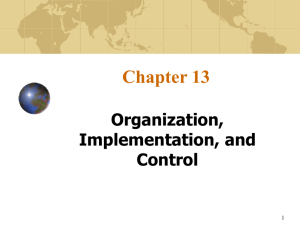

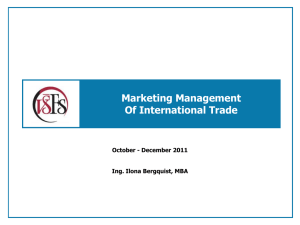
![[DOCX 51.43KB]](http://s3.studylib.net/store/data/007172908_1-9fbe7e9e1240b01879b0c095d6b49d99-300x300.png)


